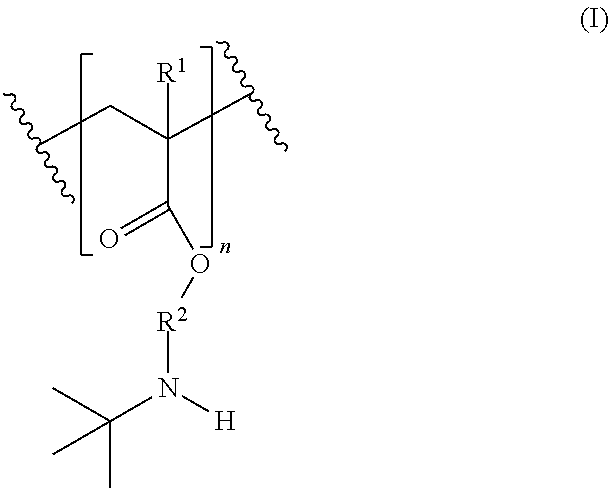Antimicrobial effects in polymers
a polymer and antimicrobial technology, applied in the field of coating and molding polymer compositions, can solve the problems of slow action, low effectiveness, quick kill tests at practical concentrations, etc., and achieve the effect of surprising antimicrobial synergistic effect on the surfa
- Summary
- Abstract
- Description
- Claims
- Application Information
AI Technical Summary
Benefits of technology
Problems solved by technology
Method used
Image
Examples
example 1
Synthesis of Homopolymer of Tert-Butylaminoethylmethacrylate (tBAEMA) Via ATRP
[0339]Into a 50 mL three neck round bottom flask reactor are charged 0.1549 g (0.1 mMole) of CuBr, 0.075 g (0.02 mMole) of CuBr2, 0.342 g of tris[2-(dimethylamino)ethyl]amine (Me6TREN) and 5.50 g of dimethyl sulfoxide (DMSO). The reactor content is mixed and sparged with nitrogen for about 10 minutes. At the same time, 18.28 g (0.1 mole) of t-butylaminoethyl methacrylate (tBAEMA) and 1.93 g (0.01 mole) Ethyl 2-bromoisobutyrate (EBiB) are mixed and sparged with nitrogen in a drop funnel for 10 minutes. The reactant content in the drop funnel is added to the reactor under nitrogen sparging to start polymerization. After polymerization under nitrogen for about 2 hours, the reactor content is precipitated in 300 mL of hexane and stirred overnight. The residual catalysts are removed from bottom DMSO phase and the polymer is recovered from the hexane phase through rotary evaporation. The polymer is re-dissolved ...
example 2
Preparation of tBAEMA Polymer (Mw of 174,000)
[0340]Following the procedure described in Example 1 of U.S. Pat. No. 6,096,800 using azobisisobutyronitrile (AIBN) initiator and tetrahydrofuran (THF) solvent, a tBAEMA homopolymer was prepared and characterized by GPC to have a weight average molecular weight (Mw) of 174,000 and a number average molecular weight of 63,000 (polydispersity index Mw / Mn=2.75).
example 3
Preparation of tBAEMA Polymer (Mw of 91,000)
[0341]Following the same procedure of Example 2 except double the amount of the THF solvent to low the initial monomer concentration, a lower MW tBAEMA homopolymer was prepared and characterized by GPC to have a weight average molecular weight (Mw) of 91,000 a number average molecular weight of 12,000 (polydispersity index Mw / Mn=7.40).
[0342]Preparation of tBAEMA homopolymers by conventional radical polymerization process. 480 g of tetrahydrofuran (THF) solvent are charged to a 1 L reactor equipped with overhead condenser and agitator. The reactor content with overhead condenser is heated to 65° C. under agitation and nitrogen sparging for 1 hour. After 1 hour nitrogen sparging and the reaction temperature reaches 65° C., 120 g of t-butylaminoethyl methacrylate (tBAEMA) monomer (M) and an initiator solution (I) comprising 10 g of AIBN (azobisisobutyronitrile) and 100 g of THF are added to the reactor slowly over about 180 minutes. The react...
PUM
| Property | Measurement | Unit |
|---|---|---|
| weight ratio | aaaaa | aaaaa |
| weight ratio | aaaaa | aaaaa |
| weight ratio | aaaaa | aaaaa |
Abstract
Description
Claims
Application Information
 Login to View More
Login to View More - R&D
- Intellectual Property
- Life Sciences
- Materials
- Tech Scout
- Unparalleled Data Quality
- Higher Quality Content
- 60% Fewer Hallucinations
Browse by: Latest US Patents, China's latest patents, Technical Efficacy Thesaurus, Application Domain, Technology Topic, Popular Technical Reports.
© 2025 PatSnap. All rights reserved.Legal|Privacy policy|Modern Slavery Act Transparency Statement|Sitemap|About US| Contact US: help@patsnap.com



